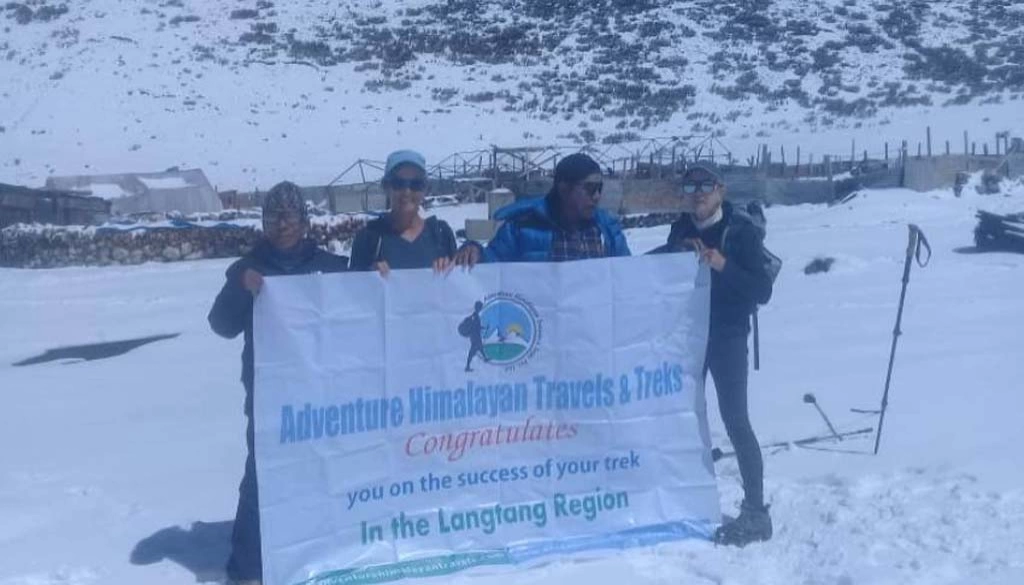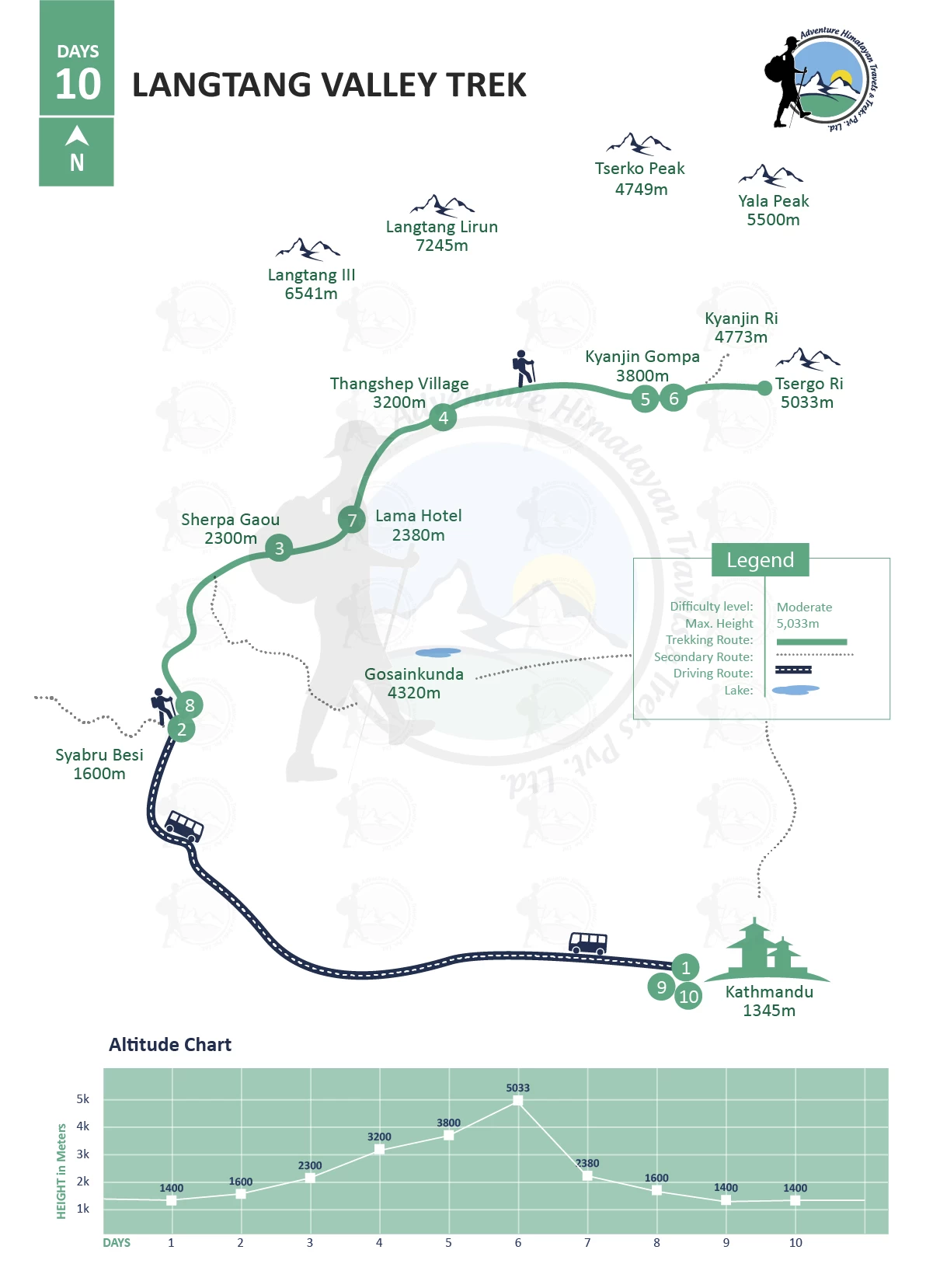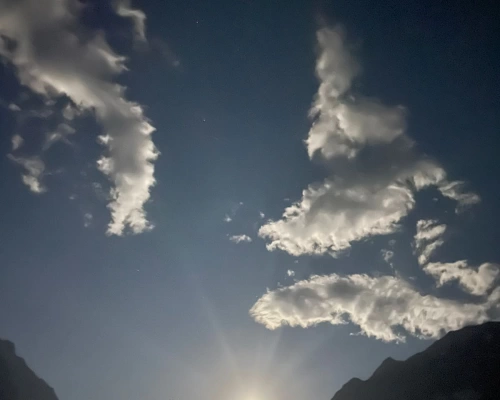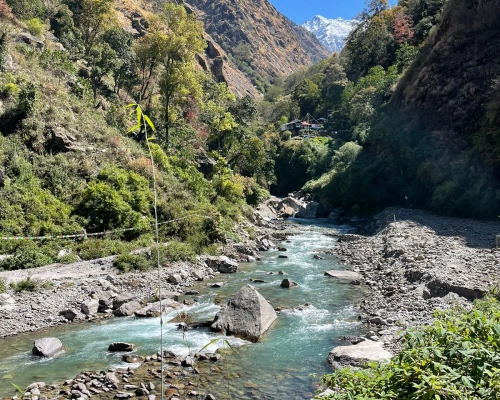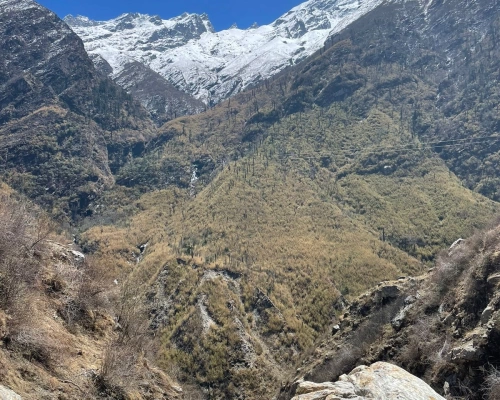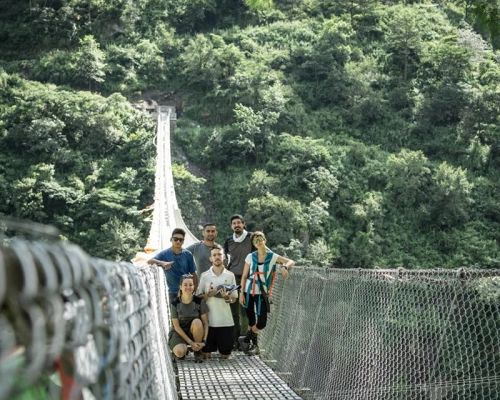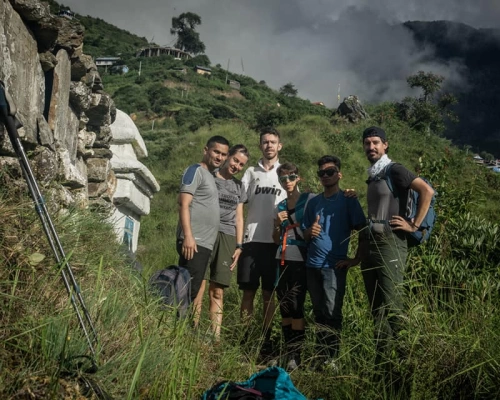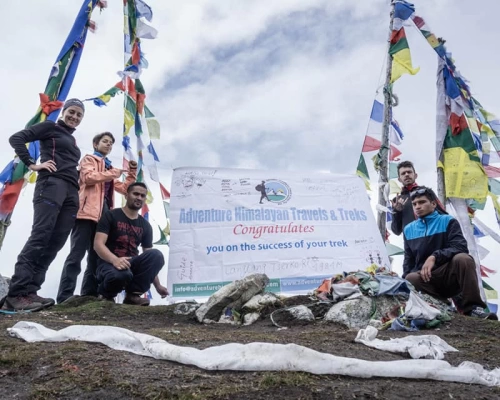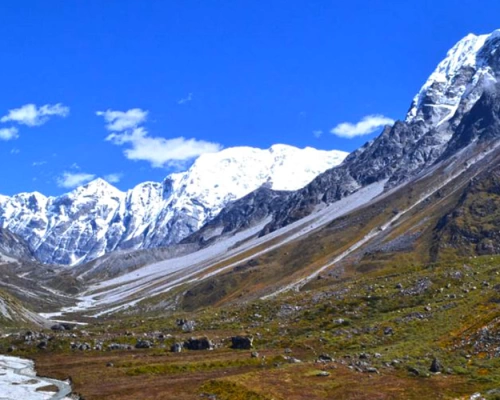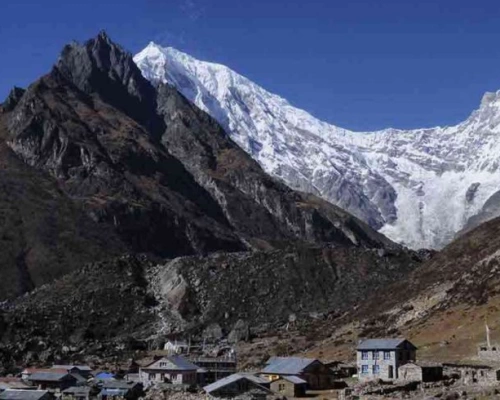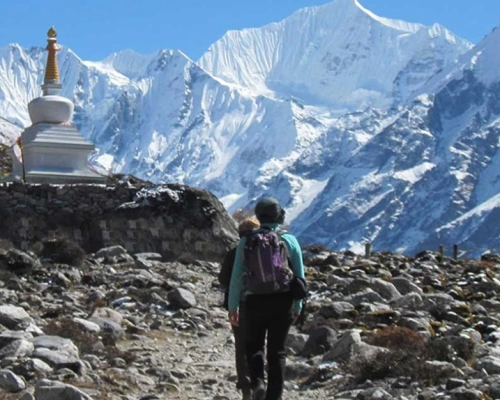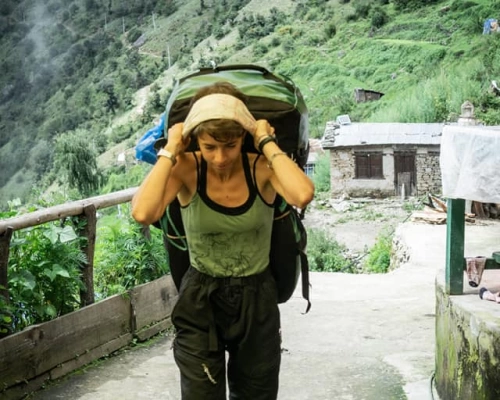The Langtang Himal region is in the northern part of Kathmandu Valley, south of the Tibetan border, surrounded by spell-binding high peaks. It has become famous ever since the British mountaineer Bill Tilman described it as the most beautiful valley in the world due to its profoundness of alpine plants, stunning Mount Langtang Lirung (7,227 m), roaring rivers, and incredible terrain in isolation.
So, the Langtang Valley trek is also known as the journey to hunt the hidden treasure in the course, full of natural and cultural diversity up to Gosaikunda and more, while the valley itself is covered with blooming flowers in the summer, followed by completely snow-clad Shisapangma, or Gosaithan 8,027 m, the highest summit in the Langtang region of Tibet.
The high Himalayan zone, with temperate and sub-alpine vegetation and dense oak forest as the major highlights of the area, including the mesmerizing rhododendron forest in the spring, is inhabited thickly by Tamang and Sherpa of Tibetan origin, quite distinct from the Sherpa of the Everest region, although both show similarity in religious practices, language and dress to Tibetan.
The Langtang valley trek combined with the Helambhu region is more stunning and provides a deep insight into the ethnic Tamang, whose origin also links to Tibet, with considerably earlier settlements in Nepal than Sherpas in the more serene upper Himalayas.
The Valley of Glaciers, Langtang Trek, is one of the shortest yet most adventurous trekking experiences to write in your diary of life. It is not only memorable but also a more comfortable and authentic off-beaten trail encompassing all the charms of the Himalayas equivalent to the Everest and Annapurna region trekking.
What to expect at the Langtang Valley Trek?
Trekking in the high Himalayas is one of the most significant ways to reflect, rebirth, and find the real you. So is the Langtang Valley Trek. It is a common destination for travelers seeking an unmatched trekking experience in the pristine Himalayas, swanky in cultural and natural heritage, which is a golden chance that many do not get to explore the real mountain lifestyle of locals, wild flora and fauna, frosty glaciers, radiant mountains, and old religious monasteries to awaken and heal themselves internally.
The Valley of Langtang is a complete package made for those looking forward to trekking in the unspoiled Himalayan environment in a short amount within your budget.
Alpine scenery and raw social culture
The pristine nature of the Himalayas offers you physically and spiritually healing lush meadows, stunning landscapes, glaciers, and majestic mountains soaring above all.
One such off-the-beaten trekking trail is the Langtang region, which seizes all the highlights no less to Everest Base Camp (EBC) and Annapurna Circuit Trek, passing through several settlements of indigenous Tamang and Sherpa, differing in family linkage, dress, and language from the Everest in more serenity and easy access than any other trekking region.
However, like every Himalayan trekking zone, this trail also tests your level of endurance in arduous alpine climatic conditions. To secure your safety at the top, cooperating with any travel and tour operators is the best option.
Striking Views of the Langtang Himalayan Ranges
Among other trekking regions of Nepal, the Langtang region stands as the unrivaled top destination. What makes it stand out among others is undoubtedly the majestic vistas of the mountain ranges beyond the sky and the unspoiled, pristine nature.
The heavenly surrounding views of Langtang Lirung (7,245 m), Dorje Lakpa (6,966 m), and Mt. Gaurishankar (7,134 m) throughout the trekking trail, and special glances from different vantage points and stopping points add more to the journey to die for.
The lush and blooming forests and hills, shimmering rivers and waterfalls, and untamed, rare wildlife are extra treats of the trek. You will pass several such beautiful and dense forests of rhododendrons and oaks throughout the trail. On a clear day, the view of Mt. Annapurna and Ganesh is magical to grasp all in.
The natural fascination of Langtang National Park
Langtang National Park is nestled in the foothills of the Himalayas. The true natural gem of the Langtang region, abundant in flora and fauna with some of the most exclusive wildlife such as black bear, Himalayan Thar, red panda, and dzo, as well as rare species of deer and monkeys, was established in 1976 with the main objective of conserving the authentic natural beauty of the country.
Any kind of vacation, trekking experience, or expedition in the Langtang region is full of thrills while embracing the tropical and alpine forests on diverse landscapes compassed by stunning peaks such as Langtang Lirung, Yala Peak, Gangchhempo, etc.
While the natural hot spring, Gosaikunda’s holiest significance and allure are unmatchable to any others, the sacred warm spring receives thousands of pilgrimages each year, mainly on the occasion of Janai Purnima in August or September.
Magnificent Glaciers
The valley of Langtang has a massive number of icy glaciers, so the valley is also known as ‘ the valley of glaciers’. The longest glacier in the Langtang region flows from the Himalayan summit of Langtang Lirung, with altitudes ranging from 4,500 m to 7,000 m covered largely by debris.
These glaciers create a crispy and sensational mood on the trail, making it the most pleasurable experience of trekking.
Must see Kyanjin Gompa
The last habitual land of the Langtang Valley is Kyanjin Gompa, the most honored and religiously important ancient monastery estimated to be 400 years old at the bottom of Langtang Lirung (7,227 m), Langshisha Ri (6,427 m), and Dorje Lakpa (6,966 m).
The Gompa is revered as the most sacred and notable Buddhist pilgrimage site, bordered by a small settlement, to learn basic aspects of Buddhist culture and Buddhism. The whole region is named after this tiny inhabitant, which is a main acclimatization spot to adapt to the high Himalayan altitude and avoid mountain sickness.
Once Must Visit Tsergo Ri
One of the major attractions of the Langtang Region is Tsergo Ri. It is the highest vantage point you will trek to on our 10-day Langtang Valley package, with incredible views of the nearby landscapes and extraordinary sights of moraines, glaciers, and the Himalayan peaks.
It is a must-visit viewpoint at an elevation of 5,000 m above sea level in the Langtang National Park of Nepal, as the top of Tsergo Ri grants you a breathtaking, complete 360-degree view of encompassing mountain ranges worth a hike.
The trek to Tsergo usually begins in Kyanjin Gompa, located at 3,800 m above sea level, which is a 4-hour walk from Tsergo Ri. You are advised to carry water and food supplements before you begin the hike, as there aren’t any other water sources available en route except the local lodges and tea houses.
Easy access to the off-beaten trail
Langtang is an easy destination to trek from the Kathmandu Valley, located in the north. It is one of the closest and most easily accessible trekking routes from the capital city, which is only a 7-8 hour drive.
The trekking official starts from Syabrubeshi, the gateway of Langtang, which follows a comfortable off-beaten route to Kyanjin Gompa (3,803 m), the human settlement at the highest elevation of the Langtang region.
Overall, the Langatnag region is the grandest alternative to the Annapurna base camp or the Everest base camp for every healthy trekker bound by limited time.
Langtang Valley Trek: Is this trek right for you?
Adding Langtang Valley Trek to your bucket list is an excellent decision, as it is one of the most suitable trekking destinations, ideal for all age groups and families that go through the daily traveled route of the locals from many lovely Sherpa and Tamang dwellings, ensuring your safety.
Any healthy individual with the habit of hiking for a few hours without serious health ailments is fit and ready to go on this rewarding trek.
If you aspire to witness the true Himalayas and the life it supports to add a grand voyage to take pride in, Langtang Valley Trek is a fantastic trekking you must set on for, right now!
Trek Cost
Arguably, the Langtang Valley trek is one of the most budget-friendly trekking experiences in Nepal, which is reasonable and affordable at the same time as compared to any trek in the Everest region and the Annapurna region.
Generally, the Langtang Valley trek cost ranges from USD 775 to USD 900 per person for 10–13 days based on several factors such as the season, condition of accommodation, mode of transportation, and the type of services you have chosen.
The trek cost also varies from travel and trekking agencies to agencies. Some travel and tour operators may charge you around USD 700, while others may ask for more than USD 1,500, which is for a standard trekking package.
The luxurious package, including helicopter return, will cost you slightly more than the general packages, which tend to go higher if you extend your trekking days or add other luxury options.
So, cost planning plays a vital role in any kind of trekking you are looking forward to, which helps you ensure your trip quality, experience, and realistic budget formation. In the absence of proper trekking cost planning, you ought to compromise on your essentials, such as nutrients, accommodation, and means of transportation for the trek. To ensure a pleasant trekking experience, trek cost planning is a crucial matter that mustn’t be ignored at all.
Overall, the Langtang Valley trek is among the most popularly priced treks in Nepal due to multiple reasons. Here are the few main aspects that make it one of the best trek choices for budget-conscious trekkers:
The cost of trekking permits regulated for the Langtang Valley trek is inexpensive in comparison to other different trekking regions. As the Langtang Valley is a few hours' drive from the Kathmandu Valley, you will save a significant dollar that could have been an airfare charge.
Even though the Langtang Valley Trek grades moderately, it does not ask for any exclusive or advanced equipment or gear, making the trek to Langtang the most beneficial on the list.
To make it more within your budget, here are some tips:
Try your best to buy snacks and other essential trek equipment from the city.
Renting the required trekking gear can greatly minimize the cost.
Choose budget-friendly trekking accommodations: lodging trekking and tea house trekking.
Always carry extra batteries and a power bank to charge your electronic devices.
Avoiding non-veg can save some dollars.
To prevent yourself from consuming junk food, sticking to Dal Bhaat is a great way to make the trek more budget-friendly
How to prepare yourself for the Langtang Valley trek?
Although there aren’t any mandatory physical preparation procedures required to trek the Langtang Valley, normal daily exercise can ease the trail, which is full of repeating ascents and descents. On this factor, youngsters are more on the safer side as compared to older people, despite the expertise they have held for years.
Here is a list of things to do that can help greatly while you trek in the Langtang Valley, regardless of age, experience, and technical knowledge.
Any sort of difficult potential trek can be tackled with some warm-up cardiovascular and weight-lifting training, even before the beginning of the trek.
Hiking local tracks and trails can be a great alternative for increasing the muscle's strength.
Regular jogging, running, or rapid walking is likely to enhance your breathing capacity even at low oxygen levels, which is a crucial concern in the higher Himalayas.
Form a healthy eating pattern, and if possible, try your best to avoid foods containing excessive fat and oil.
Wise and responsible travelers prefer to ditch alcohol and nicotine.
A well-made trek costs planning.
Digging up substantial information about the trek that you want to hop for
What to pack for the Langtang trek?
Appropriate packing is a fundamental part of the trek. While what to pack for trekking in Nepal can be distinct from region to region and might be slightly more time-consuming, starting to pack earlier, even before you arrive in Kathmandu, Nepal, can be a wise thing to do.
To trek the Langtang, here are some of the most essential gear and equipment to add to your backpack, fit for your torso with wide shoulder straps.
Choose the water-resistant backpack or make sure to grab a light raincoat to overcome the unpredictable Himalayan weather.
Hiking poles are great for knees.
An extra comfortable blanket.
The three layers of clothes: the very basic one to soak up moisture, the second layer to maintain warmth in your body, and the outer one to protect you from wind and rain.
Air-passable set of undergarments made up of wool.
Be in the ultimate serenity of the Himalayas on the Langtang Valley Trek
Nepal would never be off the list of must-travel countries for the Himalayan adventure aspirant whose goal is to experience the actual essence of the Himalayas.
One such trek you take yourself on is the Langtang Valley Trek, which not only takes you closer to the grand mountains of Nepal but also lets you free yourself in the valleys it shelters with its authentic culture of the natives, enduring and dancing in the hardships of the Himalayan region.
It is not to miss a chance to roam around the scenic wide range of landscapes far away from the crowdy hustle and bustle of the cities while we make your safety and satisfaction our utmost priority.
Adventure Himalayan Travels and Treks has been dedicated to making your adventure fruitful for decades with specialized travel and trek experts at your service, able to meet every need of our satisfied clients in each expedition we organize.
Let us be at your service to fulfill your dream of being in what seems like a supernatural palace to exist in the world.
